Papers by Francesca Luciani
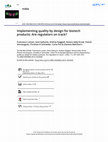
mAbs, Jan 8, 2015
Quality by design (QbD) is an innovative approach to drug development that has started to be impl... more Quality by design (QbD) is an innovative approach to drug development that has started to be implemented into the regulatory framework, but currently mainly for chemical drugs. The recent marketing authorization of the first monoclonal antibody developed using extensive QbD concepts in the European Union paves the way for future further regulatory approvals of complex products employing this cutting-edge technological concept. In this paper, we report and comment on insights and lessons learnt from the non-public discussions in the European Medicines Agency's Biologicals Working Party and Committee for Medicinal Products for Human Use on the key issues during evaluation related to the implementation of an extensive QbD approach for biotechnology-derived medicinal products. Sharing these insights could prove useful for future developments in QbD for biotech products in general and monoclonal antibodies in particular.

Annali dell'Istituto superiore di sanità, 2007
We organised a collaborative study to calibrate three new ISS reference preparations (ISS: Istitu... more We organised a collaborative study to calibrate three new ISS reference preparations (ISS: Istituto Superiore di Sanità), one for HCV RNA, one for HIV RNA and one for HBV DNA, to be used for nucleic acid amplification techniques (NAT) in blood testing. Serial dilution of the ISS reference preparations and the respective international standards were tested in different days by each participating laboratory using two commercial NAT assays. Data were collected by the ISS for statistical analysis. Based on the mean potency of the HCV RNA and HIV RNA preparations, calculated from the results provided by the 12 participating laboratories, a definitive concentrations of 5700 IU/mL and 4000 IU/mL, respectively, were assigned to the reference materials. On the contrary, it was not possible to obtain a consensus titre for the HBV DNA reference material. These new Italian reference preparations (HCV RNA ISS/1005 and HIV RNA ISS/1005) calibrated against the respective international standards ar...

Journal of Thrombosis and Haemostasis, 2004
ABSTRACT An international collaborative study was organized to calibrate a replacement for the cu... more ABSTRACT An international collaborative study was organized to calibrate a replacement for the current (2nd) International Standard (IS) for Streptokinase, stocks of which are almost exhausted. Two candidate preparations were assayed against the 2nd IS in a study involving 16 laboratories in 12 countries: preparation 88/824 (coded B), and preparation 00/464 (C and D, coded duplicates). Laboratories could use two methods provided, either a fibrin clot lysis assay or a solution chromogenic method, or an in-house method. Laboratories were encouraged to perform more than one method if possible. With the exception of one laboratory which gave outlying results for preparation 00/464, there was good agreement within and between laboratories and no significant differences between potencies using the different methods employed. This study demonstrates that a solution chromogenic assay is an acceptable format for potency determination of the streptokinase preparations in this study and fibrin is not necessary. It has now been agreed that a solution chromogenic plasminogen activation assay replace the current euglobulin reference method for streptokinase activity determination in the European Pharmacopoeia. Study participants, SSC of the International Society on Thrombosis and Haemostasis and the Expert Committee on Biological Standardization (ECBS) at the World Health Organization approved preparation 00/464 (C,D in the study) as the 3rd IS for Streptokinase with a potency of 1030 IU per ampoule.
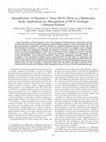
Journal of Clinical Microbiology, 2009
Assessment of the viral load in hepatitis C virus (HCV) genotype 1-infected patients is critical ... more Assessment of the viral load in hepatitis C virus (HCV) genotype 1-infected patients is critical before, during, and after antiviral therapy. In patients achieving a rapid virological response at week 4 of treatment, the viral load at the baseline is considered a predictive criterion of a sustained virological response 24 weeks after the discontinuation of treatment. A ≥2-log 10 drop in the viral load at week 12 of treatment (early virological response) triggers the continuation of therapy. We organized a multicenter study (MS) for diagnostic laboratories involved in the quantification of HCV RNA. Commercial assays, including two based on real-time reverse transcription-PCR (TaqMan system), and in-house methods, were used by the 61 participants. The overall reproducibility of the commercial quantitative nucleic acid amplification techniques (qNAT) was acceptable. As the intermethod variability among commercial qNAT for HCV RNA was still present, the manufacturers of these test kits ...
Acknowledgements development of the Hypercritical Separation Technology. A special acknowledgment... more Acknowledgements development of the Hypercritical Separation Technology. A special acknowledgment to the inventor of the Hypercritical Separation Technology, Engineer Umberto MANOLA. (both animal and human) and renewable energy. The process carries out the physical disaggregation of the plant tissues followed by multiple requires only a small amount of electric energy, i.e. about 20 kWh/t. When applied to the animal production sector, the HYST processing of corn
Pathways to Environmental Sustainability, 2014

Blood transfusion = Trasfusione del sangue, 2012
A second Italian external quality assessment programme was run in 2011 to assess the performance ... more A second Italian external quality assessment programme was run in 2011 to assess the performance of blood transfusion centres in detecting West Nile virus RNA in plasma. Each participant received two panels containing negative samples and samples positive for West Nile virus lineages 1 and 2, some of which with a viral concentration close to or below the 95% limit of detection of the respective commercial nucleic acid amplification test assay: the PROCLEIX WNV assay or the Cobas TaqScreen West Nile virus test. Eleven laboratories took part in the external quality assessment programme. All of them correctly identified the positive samples with a viral concentration above the 95% limit of detection. No false positive results or pre-/post-analytical errors were observed. The External quality assessment programme run in 2011 allowed participants to assess the performance of the nucleic acid amplification test methods applied in their seasonal routine screening of blood donations. The re...

Biologicals : journal of the International Association of Biological Standardization, 2021
A new, simple and rapid method for the quantitative determination of the antimicrobial preservati... more A new, simple and rapid method for the quantitative determination of the antimicrobial preservative 2-phenoxyethanol, based on reverse phase ultra-high-performance liquid chromatography has been developed. The validation was performed according the ICH Q2 guideline "Validation of Analytical Procedures". The desired chromatographic separation was achieved on a Waters Symmetry C18 (150 × 4.6 mm, 5 μm) column using an isocratic elution, with detection at 270 nm wavelength. The mobile phase consisted of acetonitrile/water (55:45, v/v), pumped at a flow rate of 1 mL/min. The calibration curve and the analytical procedure are linear (r2 = 0.999) from the concentration of 0.07 mg/mL to 1.1 mg/mL. The percent relative standard deviation for intra- and inter-day precision was <1%. The recovery of 2-phenoxyethanol in vaccines ranged between 96.5 and 100.60%. The limits of detection and quantitation were 1.3 × 10-4 and 2.7 × 10-4 mg/mL, respectively. The method was found to be rob...
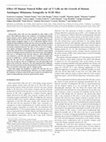
Cancer research, 2004
Natural killer (NK) cells were first identified for their ability to kill tumor cells of differen... more Natural killer (NK) cells were first identified for their ability to kill tumor cells of different origin in vitro. Similarly, gammadelta T lymphocytes display strong cytotoxic activity against various tumor cell lines. However, the ability of both the NK and gammadelta cells to mediate natural immune response against human malignant tumors in vivo is still poorly defined. Severe combined immunodeficient (SCID) mice have been successfully engrafted with human tumors. In this study, the antitumor effect of local as well as of systemic treatments based on NK cells or Vdelta1 or Vdelta2 gamma/delta T lymphocytes against autologous melanoma cells was investigated in vivo. The results show that all three of the populations were effective in preventing growth of autologous human melanomas when both tumor and lymphoid cells were s.c. inoculated at the same site. However, when lymphoid cells were infused i.v., only NK cells and Vdelta1 gamma/delta T lymphocytes could either prevent or inhib...

Histology and histopathology, 2000
Asymmetric organization of the plasma membrane and cytosolic organelles is fundamental for a vari... more Asymmetric organization of the plasma membrane and cytosolic organelles is fundamental for a variety of cells, including bacteria, yeast and eukaryotic cells (Nelson, 1992). The degree into which cells polarize is characterized by their ability to create and maintain morphologically and biochemically distinct plasma membrane domains. The generation and maintenance of polarized distribution of membrane components (proteins and lipids) is thus critical to the ability of cells to perform complex activities such as cell-to-cell interactions, vectorial transport and secretion, cellular immunity, development and morphogenesis. Modification of cellular polarity may potentially lead to abnormal cellular activities and various pathological disorders (Molitoris, 1991; Carone et al., 1994; Chen et al., 1995). Our review shows the complex interplay between membrane proteins and the cytoskeletal network in determining the "polarized phenotype" in the cell. We provide evidence that memb...

Laboratory investigation; a journal of technical methods and pathology, 1999
P-glycoprotein (Pgp), the product of the multidrug resistance (MDR1) gene, is expressed in a vari... more P-glycoprotein (Pgp), the product of the multidrug resistance (MDR1) gene, is expressed in a variety of normal tissues but very little is known about its expression and function in cells of the immune system. In this study, we investigated the effect of interferon-gamma (IFN-gamma) on the expression and activity of Pgp in human peripheral blood monocyte-derived macrophages (MDM). We report that IFN-gamma up-regulated Pgp expression in a dose- and time-dependent manner. We show that IFN-gamma slightly increased the accumulation of MDR1 mRNA and induced a polarized redistribution of Pgp, as well as of some cytoskeletal proteins (ie, ezrin, actin, and alpha-actinin) on cell pseudopodia. Notably, confocal microscopy studies showed that Pgp and ezrin colocalized in these cellular structures. The IFN-gamma-induced Pgp up-modulation was a specific response of primary macrophages, as IFN-gamma treatment of primary lymphocytes and monocytic cell lines did not result in any increase of Pgp ex...

P-glycoprotein is a 170-kd glycosylated transmembrane protein, expressed in a variety of human ce... more P-glycoprotein is a 170-kd glycosylated transmembrane protein, expressed in a variety of human cells and belonging to the adenosine triphosphate-binding cassette transporter family, whose membrane expression is functionally associated with the multidrug resistance phenotype. However, the mechanisms underlying the regulation of P-glycoprotein functions remain unclear. On the basis of some evidence suggesting P-glycoprotein-actin cytoskeleton interaction, this study investigated the association of Pglycoprotein with ezrin, radixin, and moesin, a class of proteins that cross-link actin filaments with plasma membrane in a human cell line of lymphoid origin and that have been shown to link other ionpump-related proteins. To this purpose, a multidrug-resistant variant of CCRF-CEM cells (CEM-VBL100) was used as a model to investigate the following: (1) the cellular localizations of P-glycoprotein and ezrin, radixin, and moesin and their molecular associations; and (2) the effects of ezrin, radixin, and moesin antisense oligonucleotides on multidrug resistance and P-glycoprotein function. The results showed that: (1) P-glycoprotein colocalized and coimmunoprecipitated with ezrin, radixin, and moesin; and (2) treatment with antisense oligonucleotides for ezrin, radixin, and moesin restored drug susceptibility consistently with inhibition of both drug efflux and actin-P-glycoprotein association and induction of cellular redistribution of P-glycoprotein. These data suggest that P-glycoprotein association with the actin cytoskeleton through ezrin, radixin, and moesin is key in conferring to human lymphoid cells a multidrug resistance phenotype. Strategies aimed at inhibiting P-glycoprotein-actin association may be helpful in increasing the efficiency of both antitumor and antiviral therapies. (Blood. 2002;99:641-648)
Platinum and Other Heavy Metal Compounds in Cancer Chemotherapy, 2009
Resistance to antitumor agents is a major cause of treatment failure in patients with cancer. Som... more Resistance to antitumor agents is a major cause of treatment failure in patients with cancer. Some mechanisms of tumor resistance to cytotoxic drugs may involve increased acidification of extracellular compartments. We investigated whether proton pump inhibitors (PPI), currently used in the anti-acid treatment of peptic disease, could inhibit the acidification of the tumor microenvironment and increase the sensitivity of tumor
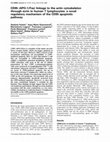
The EMBO Journal, 2000
contributed equally to this work CD95 (APO-1/Fas) is a member of the tumor necrosis factor recept... more contributed equally to this work CD95 (APO-1/Fas) is a member of the tumor necrosis factor receptor family, which can trigger apoptosis in a variety of cell types. However, little is known of the mechanisms underlying cell susceptibility to CD95mediated apoptosis. Here we show that human T cells that are susceptible to CD95-mediated apoptosis, exhibit a constitutive polarized morphology, and that CD95 colocalizes with ezrin at the site of cellular polarization. In fact, CD95 co-immunoprecipitates with ezrin exclusively in lymphoblastoid CD4 + T cells and primary long-term activated T lymphocytes, which are prone to CD95-mediated apoptosis, but not in short-term activated T lymphocytes, which are refractory to the same stimuli, even expressing equal levels of CD95 on the cell membrane. Pre-treatment with ezrin antisense oligonucleotides speci®cally protected from the CD95-mediated apoptosis. Moreover, we show that the actin cytoskeleton integrity is essential for this function. These ®ndings strongly suggest that the CD95 cell membrane polarization, through an ezrin-mediated association with the actin cytoskeleton, is a key intracellular mechanism in rendering human T lymphocytes susceptible to the CD95-mediated apoptosis. Keywords: apoptosis/CD95 Fas/cytoskeleton/ezrin/ polarization
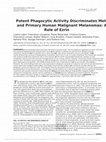
Laboratory Investigation, 2003
Features of phagocytosis have been observed in human tumors, but the phagocytic apparatus of tumo... more Features of phagocytosis have been observed in human tumors, but the phagocytic apparatus of tumor cells and the mechanism(s) underlying this phenomenon have yet to be defined. To address the phenomenon of phagocytosis, its underlying mechanism(s), and its possible role in tumor biology, we used human melanoma cells as a prototypic model. Our results showed that a process of phagocytosis of apoptotic cells occurs in vivo in human melanoma. This finding was consistent with evidence that human melanoma cells in vitro express all of the known lysosomal and phagocytic markers on their cytoplasmic vesicles and that a process of phagocytosis occurs in these vesicles. However, exclusively human melanoma cells deriving from metastatic lesions possess an efficient phagocytic machinery responsible for a macrophage-like activity against latex beads, yeast, and apoptotic cells of different origins, which was comparable to that of human primary macrophages. Moreover, the actin-binding protein ezrin was expressed on phagocytic vacuoles of melanoma cells and of cells deriving from a human adenocarcinoma; both treatment with cytochalasin B and specific inhibition of ezrin synthesis strongly affected the phagocytic activity of melanoma cells. This suggests that the association with the actin cytoskeleton is a crucial requirement for the development of this phenomenon. Hence our data provide evidence for a potent phagocytic activity exerted by metastatic melanoma cells possibly involved in determining the level of aggressiveness of human melanoma. This suggests that the assessment of phagocytic activity may be exploited as a new tool to evaluate the malignancy of human melanoma. Moreover, our data suggest that gene therapy or drug treatments aimed at inhibiting actin assembly to the phagosomal membranes may be proposed as a new strategy for the control of tumor aggressiveness. (Lab Invest 2003, 83:1555-1567.
Uploads
Papers by Francesca Luciani